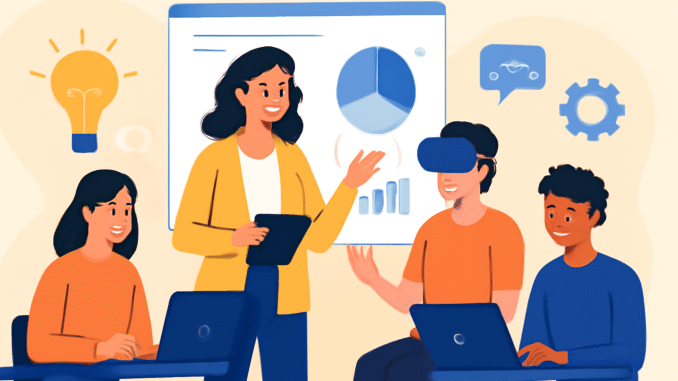
5 Innovative Teaching Methods Revolutionizing Education in 2025
Education is one of the most vital components of society, shaping individuals’ futures and driving progress in every field. Over the past decade, the landscape of education has undergone dramatic shifts, largely driven by technological advancements and a deeper understanding of how students learn best. As we approach 2025, several innovative teaching methods are emerging, revolutionizing the way knowledge is imparted and acquired. These methods not only enhance the learning experience but also prepare students for the challenges of the future.
In this article, we’ll explore five innovative teaching methods that are transforming education in 2025 and beyond.
1. Personalized Learning: Tailoring Education to Individual Needs
Personalized learning has been gaining momentum in recent years, and by 2025, it is set to become the norm in classrooms worldwide. Unlike traditional one-size-fits-all teaching methods, personalized learning recognizes that each student has unique strengths, weaknesses, and learning styles. This approach aims to cater to the individual needs of each student, creating a more effective and engaging learning experience.
Key Features of Personalized Learning:
- Adaptive Learning Technology: One of the core drivers of personalized learning is the use of adaptive learning technology. Platforms powered by artificial intelligence (AI) assess students’ performance in real time, adjusting the difficulty of lessons based on their progress. This allows students to learn at their own pace and receive targeted support when needed.
- Flexible Learning Pathways: Personalized learning empowers students to follow flexible learning pathways, where they can explore subjects in greater depth or focus on areas where they need more help. Whether it’s through project-based learning or digital platforms, students can tailor their educational journeys according to their interests and goals.
- Data-Driven Insights: Teachers and educators use data analytics to track students’ progress, identify areas for improvement, and modify their teaching strategies accordingly. This data-driven approach ensures that no student is left behind and that each learner’s potential is maximized.
Impact on Education:
Personalized learning helps foster a deeper connection to the material, as students feel more invested in their own learning. It also ensures that students who may struggle with traditional teaching methods have the opportunity to excel. Personalized learning could eventually become the most effective way to address the diverse needs of a classroom, providing all students with a chance to thrive.
2. Gamification: Turning Learning Into an Engaging Game
Gamification, the process of integrating game elements into educational activities, has been a growing trend in recent years. By 2025, it is expected that gamification will become a central feature of classrooms worldwide. The use of game-like elements such as points, badges, leaderboards, and rewards can make learning more interactive, engaging, and fun.
Key Features of Gamification:
- Progress Tracking: Similar to levels in a video game, students progress through various stages of learning, earning points or rewards for completing tasks and challenges. This continuous progression motivates students to keep pushing forward.
- Interactive Learning: By incorporating problem-solving scenarios, quizzes, and simulations, gamified learning encourages active participation. Students are often more eager to engage in tasks that are framed as games, which increases their retention of the material.
- Friendly Competition: Leaderboards and team-based activities foster a healthy sense of competition and collaboration. Students can compete against their peers or collaborate in groups, which helps build teamwork and social skills.
Impact on Education:
Gamification taps into students’ natural desire for competition and achievement, making learning more enjoyable. It encourages perseverance and resilience, as students learn to overcome challenges to earn rewards. Gamified learning is also highly adaptable, meaning it can be tailored to different subjects, age groups, and educational levels.
3. Virtual and Augmented Reality (VR/AR): Creating Immersive Learning Environments
Virtual and Augmented Reality are technologies that have been making waves in the educational sector for their potential to create immersive learning experiences. By 2025, these technologies will likely play a major role in revolutionizing education, particularly in fields such as science, history, and the arts.
Key Features of VR/AR in Education:
- Immersive Simulations: VR allows students to “experience” lessons in a virtual environment. For example, students studying history can virtually visit ancient civilizations, or biology students can explore the human body from the inside. These immersive experiences enhance comprehension and retention.
- Hands-on Learning: With AR, students can interact with digital elements overlaid on the real world. This could involve solving complex mathematical problems with 3D objects or manipulating molecular structures in a science class.
- Safe Experimentation: VR and AR also provide a safe environment for experimentation. Students can conduct virtual chemistry experiments, for example, without the risk of harmful chemicals or explosions. This hands-on approach reinforces theoretical learning in a way that traditional textbooks cannot.
Impact on Education:
Virtual and Augmented Reality have the power to transform how students interact with content. Instead of passively receiving information, students can immerse themselves in dynamic, interactive environments that enhance their understanding. This approach not only fosters engagement but also provides access to experiences that would be impossible in a traditional classroom setting.
4. Project-Based Learning (PBL): Fostering Critical Thinking and Real-World Skills
Project-Based Learning (PBL) is an instructional method in which students learn by actively engaging in real-world projects. Rather than merely absorbing information through lectures or textbooks, students in a PBL environment work collaboratively to solve problems, conduct research, and produce tangible outcomes.
Key Features of Project-Based Learning:
- Real-World Relevance: PBL encourages students to tackle real-world issues that have a direct impact on their communities, professions, or personal interests. This relevance makes learning more meaningful and motivates students to apply their knowledge in practical ways.
- Collaboration: In PBL, students often work in teams, which promotes collaboration and the development of interpersonal skills. Working together on a project fosters creativity, critical thinking, and problem-solving abilities.
- Student Autonomy: PBL allows students to take ownership of their learning, as they are involved in decision-making processes, project design, and execution. This sense of autonomy builds confidence and independence.
Impact on Education:
Project-Based Learning helps develop skills that are essential in the modern workplace, such as critical thinking, collaboration, and creativity. By 2025, PBL is expected to be widely adopted as a central method of teaching, as it better prepares students for the challenges they will face in the workforce and in their personal lives.
5. Artificial Intelligence and Chatbots: Enhancing Learning Through Technology
Artificial Intelligence (AI) and chatbots are rapidly making their way into classrooms as tools for enhancing teaching and learning. By 2025, these technologies will likely be integrated into both K-12 and higher education settings, helping students and educators alike.
Key Features of AI and Chatbots in Education:
- AI Tutors: AI-powered tutoring systems can provide students with on-demand help, answering questions and offering explanations at any time. These systems can adapt to a student’s needs, providing personalized support and feedback, similar to a human tutor.
- Automated Grading and Feedback: AI systems can assist teachers by automating grading, providing instant feedback on assignments and exams. This frees up educators to focus on teaching and interacting with students, rather than spending excessive time on administrative tasks.
- Smart Content Creation: AI can also assist in creating educational content tailored to the needs of specific students. From generating custom quizzes to suggesting additional resources, AI helps personalize the learning experience even further.
Impact on Education:
The integration of AI in education reduces the workload on teachers and provides students with continuous, personalized learning support. As AI tools become more advanced, they will play an increasingly central role in ensuring that every student has access to high-quality education, no matter their location or background.
Conclusion
The world of education is changing rapidly, and by 2025, these five innovative teaching methods—personalized learning, gamification, VR/AR, project-based learning, and AI-powered tools—are set to transform the classroom experience. These advancements are not only making learning more engaging and personalized but are also helping students develop the critical skills they will need to thrive in the 21st century.
As we move toward a more digital and interconnected world, it’s clear that these innovative methods will continue to evolve, creating even more dynamic and inclusive learning environments. For educators and students alike, embracing these new approaches will be key to ensuring a bright and successful future for education.

